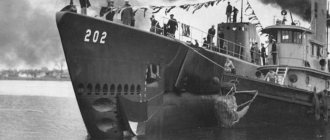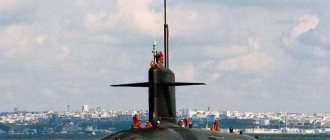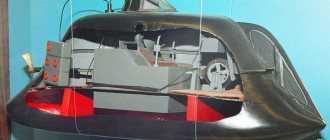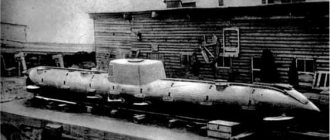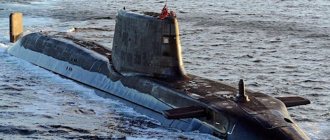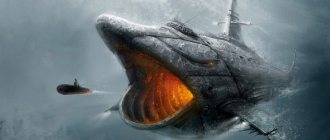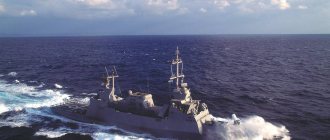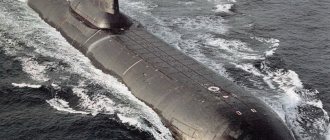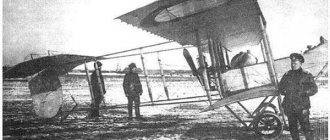One of the main tasks of warships that operate autonomously under water for a long time is to destroy enemy strategic targets. The most dangerous submarines in the world are found in the fleets of leading maritime powers, with American submarines taking the leading positions.
Submarines capable of inflicting maximum damage have a number of distinctive characteristics. In particular, the tactical advantage of a submarine largely depends on the type of weapons, their quantity, the distance from which the strike is made, the speed and depth of immersion, and the autonomy of navigation.
"Barracuda"
French multi-purpose nuclear submarine project, created to replace the Ruby-class submarines. The launch of the lead submarine Suffren Q284 took place in 2022. The ship was named after the French admiral. There are plans to create five more combat vehicles. Each new submarine will replace the outdated model of the Rubis project.
In terms of displacement they are inferior to the submarines of the Astute and Virginia type, but are 2 times higher than the data of the Ruby project. The construction of the Barracuda is a priority for the French fleet. Almost 8 billion euros have been allocated for its implementation within the planned time frame.
Peculiarities:
- 4 torpedo tubes of 533 mm caliber;
- MdCN cruise missiles, supersonic anti-ship missiles;
- hull length - 99 m;
- 50 days of autonomous navigation;
- underwater speed - 23 knots;
- destruction range - 1 thousand km.
The most dangerous submarines in the world
Also among the nuclear submarines are the most dangerous inhabitants of the seas. Among the most terrible predators, 4 can be distinguished.
- Perhaps the most unpleasant encounter on the high seas can be with the Yasen submarine; it has no equal in battle on the high seas. Its diving depth is 600 meters, and its armament includes: 10 torpedo compartments and 8 missile compartments in which 32 cruise missiles are waiting in the wings. Their power could be observed firsthand when in 2014, at a distance of 3,000 kilometers, the Yasen struck terrorist groups in Syria. Among the disadvantages there is not even high noise during movement; if a silent attack is needed, then the submarine has low-speed electric motors.
- The Borei submarine is not only one of the most powerful, but it is also the quietest submarine in the world. It is armed with missiles of enormous range, the target can be taken 8,000 kilometers away, and it is almost impossible to shoot them down, since they can change their course up to 10 times. The submarine's immersion depth is 480 meters, and with the help of a self-powered reactor, the submarine can survive for 3 months.
- The United States also does not stand aside and America considers its Virginia submarines to be one of the most powerful, at least within its submarine fleet this title cannot be taken away from it. Their range and autonomy are not limited; the only obstacle can be the hunger of the crew, which has 120 people on the submarine. "Virginia" replaced the "Seawolf", which could dive to a depth of 600 meters. Very often, many people compare this nuclear submarine and the Yasen, but if the Russian device is intended more for open combat, then the Virginia will be more useful when collecting intelligence. In place of the standard periscope, retractable masts with cameras are installed that support excellent resolution. The submarine also picks up speed up to 46 kilometers per hour, and under water even 65. There are not many of these nuclear submarines, seven, but at the moment the armed forces of the states are actively introducing these ships.
- Other countries besides Russia and the United States are somewhat behind in the development of the submarine fleet, but also have their own convincing arguments under water. So the UK built the “Astyut”, which means “Astute”, there is only one such example and it is inferior to its counterparts from Russia and America, but nevertheless, on the island state it is considered the best and is armed with 38 Tomahawk missiles, and its nuclear and water-jet engines provide navigation autonomy of up to 90 days (three months). Its speed under water is 54 km/h, and its crew of 98 people can dive to a depth of 300 meters.
S119 "Astute"
Submarines of this class are part of the Royal Navy of Great Britain. Of the 7 nuclear submarines, five combat vehicles are operational, and the last two are still under construction. The fifth submarine of the Astyut project was launched in April 2022. The ceremony was timed to coincide with the 150th anniversary of the enterprise where submarines are built.
When creating a submarine, special attention is paid to acoustic advantages. Thanks to the installation of a pressurized water reactor, the nuclear submarine does not need to reload the core for 25 years of continuous operation. Like many modern submarines, Astute is equipped with water-jet propulsion.
Specifications:
- 6 torpedo tubes of 533 mm caliber;
- cruise and anti-ship missiles;
- hull length - 97 m;
- underwater speed - 29 knots;
- firing range - 2500 km.
Underwater bases of deep-sea vehicles
No more is known about a number of submarines of the USSR and Russia than about the Losharik, which was first photographed quite by accident 27 years after its laying: these are submarines converted from serial nuclear submarines, designed to carry deep-sea vehicles.
Few such submarines are known:
- project 09774 KS-411 “Orenburg”, formerly boat of project 667A “Navaga”
- project 09786 BS-136 "Orenburg", converted from 667BDR "Squid"
- Project 1910/19100 “Sperm Whale” from the Project 675 submarine
- project 09787 BS-64 "Podmoskovye", built as a nuclear submarine of project 667BDRM "Dolphin"
All of them are deprived of weapons and supplemented with secret equipment, the purpose of which is not determined even by military experts.
Probably, the BS-136 and BS-64 are the main carrier of the Losharik and its upcoming unmanned replacement, the Harpsichord-2R-PM, and the KS-411 Orenburg is the drone of Project 18511 Halibut.
But the most secret ships keep their secrets securely.
"Virginia"
Nuclear-powered ships of the US Navy are multi-purpose, which are equipped with standard weapons, as well as equipment for special operations. The fleet includes 19 units of this type, with plans to build another 21 to 29 submarines. The first submarine began operations in 2004.
Thanks to the creation of the Virginia project, it is planned to replace the Los Angeles-class warships. Reduced noise levels are achieved through special coatings, a new power plant design, and a pipe insulation system. Instead of a traditional periscope, a telescopic mast is installed.
Peculiarities:
- 4 torpedo tubes;
- 12 launchers;
- hull length - 114.9 m;
- underwater speed - 34 knots;
- unlimited flotation reserve;
- firing range - more than 1500 km.
Comparative characteristics of “Barracuda” and “Los Angeles”
For comparison and a detailed study of the parameters of submarines, below are the characteristics of the 2 fastest submarines of the Russian and US Navy. For convenience, the comparison is presented in table form.
Barracuda
- Surface speed - 12.1 knots
- Underwater speed - 35.15 knots
- Dive depth - 480 m
- Vessel autonomy - 100 days
- Crew - 61 people
- Vessel length - 107.16 m
- Vessel width - 12.28 m
- Armament - torpedo-mine, air defense
Los Angeles
- Surface speed - up to 17 knots
- Underwater speed - 30-35 knots
- Immersion depth - 250-280 m
- Vessel autonomy - 80 days
- Crew - 141 people
- Vessel length - 109.7 m
- Vessel width - 10.1 m
- Armament - torpedo-mine, missile
Having studied the table, we can conclude that in order to evaluate and compare submarines, a comprehensive study of their parameters and characteristics is required. The record speed of a vessel does not guarantee a leading position “on the water”; on the contrary, it often leads to problems and additional modernization.
"Seawolf"
Multi-purpose nuclear-powered ships of the American fleet, the development of which began during the construction of Pike-class submarines on the territory of the USSR. They were planned to replace the aging models of the Los Angeles series, but due to the high cost of the project, the plan was abandoned.
Instead of the planned 30 submarines, the project has only 3 nuclear submarines, which have the best characteristics. The main task during the construction of the machines was to significantly reduce the noise level, which allows them to remain undetected at a speed of 20 knots.
Specifications:
- 8 torpedo launchers of 660 mm caliber;
- 50 missiles and torpedoes;
- length - 107.6 m;
- underwater speed - 35 knots;
- 90-day autonomy;
- destruction range - 2500 km.
Deadly "Antey" project 949
The project was specialized for the destruction of the enemy's largest aircraft carriers, protected by additional water and air transport. An excellent solution to an engineering challenge was the first and last project of this scale.
The composition of the hull structure from a light and durable hull with an intermediate distance of 3.5 meters provided up to 30% of the buoyancy reserve. Thus, Antey-class ships are protected from an accidental torpedo explosion.
Nuclear worker of project 949 “Antey” Source: Wikipedia.org
Submarines of this class carry supersonic missiles on board:
- 72 pcs P-800 “Onyx”;
- or 24 pcs P-700 “Granite”.
They are carriers of specialized Zircon hypersonic missiles, against which there is no combat protection. With a salvo shot, it is possible to intercept only one to five Onyx supersonic missiles, which significantly reduces the “survivability” of aircraft carrier groups. A salvo shot from the Zircon will be devastating.
The most tragically famous submarine of the Project 949 Antey type with a double lightweight and durable hull is the K-141 Kursk. The fate of this nuclear scientist is known, if not to all of Russia, then to every second person. As checks revealed, the Kursk sank due to a double explosion with a two-minute interval in the bow of the submarine.
"Triumfan"
A series of French nuclear-powered missile carriers, which include 4 new generation submarines. Initially it was planned to build 6 units, but after the collapse of the USSR the project was revised. The main objectives were to ensure the maximum level of noiselessness and the ability of the submarine to quickly determine the presence of the enemy.
The silhouette of the Triumphant hull is similar to the Ruby-class submarines. The combat vehicle is equipped with a pressurized water reactor, which runs on lightly enriched uranium, and a full-fledged sonar system. The latter, in particular, has a noise control system consisting of 40 sensors.
Peculiarities:
- 4 torpedo tubes of 533 mm caliber;
- 16 ballistic missiles;
- 138-meter hull length;
- underwater speed - 25 knots;
- firing range - 6-9 thousand km.
“Deep Sea Tragedy” K-278 “Komsomolets”
Submarines of Project 685 “Plavnik” were created as underwater hunters for enemy nuclear submarines, and therefore were superior to all existing analogues in both the USA and the USSR.
To develop them, a colossal testing complex was built in Severodvinsk with pressure chambers simulating a wide variety of loads at great depths. The dimensions of the complex allow us to assert that nothing like it existed either before or since.
Effective scientific work made it possible to build a boat on which, on August 4, 1985, an absolute world record for diving depth of 1027 meters and a record for the depth of underwater torpedo firing of 800 meters were set. At such a depth, submarines are unattainable by means of detection and armament of other ships to this day.
Unfortunately, after the third voyage, the boat sank, remaining in memory as one of the most tragic maritime disasters: despite the presence of an autonomous rescue capsule (through which even entry was made), 42 of the 69 crew members were killed.
To prevent radioactive contamination, it was necessary to pump polymer with chitin into the body (another unique technique). It is also planned to raise the remains of the boat. It lies at a depth of 1650 meters, so even research into its location is a record.
"Vanguard"
A series of British nuclear-powered ships, the creation of which was carried out in the 90s of the 20th century. Vanguard-class submarines were built to modernize the country's nuclear potential. In this case, the most effective design features of previous nuclear submarine models were used.
The Vanguard project has only 4 warships that are still fully operational. They are equipped with a water-cooled nuclear reactor and a modern missile system. The submarines are based at the Royal Naval Station Clyde, which is located in Scotland.
Specifications:
- 4 torpedo tubes;
- 16 ballistic missiles;
- hull length 149.9 m;
- underwater speed - 25 knots;
- destruction range - up to 11,300 km.
Project 955 "Borey" - only silence is quieter
The latest generation submarine, which carries sixteen Bulava missiles, ranks second in the ranking of the top 10 submarines - the most dangerous underwater structures. Project 955 Borei became a replacement for Type 941 submarines, incorporating only the best characteristics.
It is distinguished by a design type of propulsion device, thanks to which the range of emitted sound is reduced to the maximum possible extent. Instead of multi-bladed propellers that set the boat in motion, water-jet propulsors began to be used, which affected the noise. Now Borey-class boats have become five times quieter, pushing the Shchuka-B back.
Nuclear submarine “Borey” Source: Wikipedia.org
The multi-compartment body, combined with shock-absorbing pads, increases the promising strength of the water-jet propulsion. The surface is rubberized to suppress noise and reduce the sonar's ability to reflect/detect an enemy deep-sea vessel. For the same purposes, materials that do not contain a magnetic component are used; different classifications of PVC materials are increasingly used.
Strategic use is secret for obvious reasons; all modern nuclear submarines with such a deadly potential have not been used by any country in military conflicts, otherwise the world might not have recovered after this, turning into a fantastic dystopia of survival.
"Ash"
The multi-purpose nuclear submarine project of the Russian Federation is numbered 885. Its lead submarine is the K-560 Severodvinsk. This series of nuclear submarines should replace warships built under the Soviet Union. The plans include the construction of 9 submarines, 3 of which are already operational.
The creation of the first “Ash” took more than 20 years. The noise of submarines is reduced due to vibration-absorbing materials, soundproofing panels, rubber hull coating, and electric motors. Thus, the nuclear submarine gains more advantages in terms of stealth, which makes it more dangerous for the enemy.
Peculiarities:
- 10 torpedoes of 533 mm caliber;
- 8 launchers SM-346;
- hull length - 139 m;
- navigation autonomy - 100 days;
- underwater speed - 31 knots;
- destruction range - 2 thousand km.
Nuclear submarines by country
With the development of progress, the fleet was improved, and after filling the arsenal of countries with nuclear weapons, nuclear submarines (NPS) were created. They use a nuclear reactor to operate, and they can also carry nuclear weapons and conventional torpedoes. Only 6 countries have nuclear submarines.
- USA – 71
- Russia – 33
- China – 14
- UK – 11
- France – 10
- India – 2
The largest ATP Shark is 172.8 meters.
Among these boats there is the largest nuclear submarine in the world, it was created in the USSR in the city of Severodvinsk and was popularly nicknamed “Shark”, since this sea predator was painted on its bow, which On September 23, 1980, he disappeared from view under a veil of water. At the helm of the country was L.I. Brezhnev, and even on this occasion he made a statement that the United States has the Ohio submarine, but at the moment Russia also has similar weapons with the name Typhoon. S. N. Kovalev supervised the construction and design. The displacement of this giant was 23,200 surface, submerged 48,000 tons, it accelerates to 25 knots under water. The submarine is capable of operating at a depth of 400 meters, and the maximum permissible diving distance is 500 meters. The nuclear submarine can sail without land for 180 days, which is equal to six months, during which time the ship can carry up to 160 people, 52 of whom are officers. Its dimensions shocked many; NATO troops even coded this boat with the name SSBN “Typhoon”. It is 172.8 meters long, for comparison we can give an example of a football field, the distance of which is from 100 to 110 meters, and the width of the “Shark” was 23.3 meters. The submarine's arsenal included torpedo-mine armament: 22 torpedoes, Vodopad or Shkval missile-torpedoes. Air defense - 8 Igla MANPADS.
667BDRM "Dolphin"
A series of submarine cruisers with a nuclear power plant. The project includes 7 nuclear submarines, the first of which was launched in 1984. When creating combat vehicles, special attention was paid to weapons and control systems, as well as to reducing hydroacoustic noise.
Submarines regularly participate in firing exercises near Kamchatka. They were used to launch satellites into low-Earth orbit. The submarines are undergoing modernization in terms of technical readiness and types of weapons. Dolphin is considered the most advanced missile submarine project.
Specifications:
- 16 modernized ballistic missiles;
- 4 torpedo launchers of 533 mm caliber;
- hull length - 167 m;
- autonomy - 80-90 days;
- underwater speed - 27 knots;
- firing range - about 12 thousand km.
Maximum submersion depth
If you study submarines for a long time, you will notice that the maximum diving depth of a submarine in the world is 1027 meters. This record was set by the K-278 Komsomolets vessel. The submarine was laid down in 1966 according to the design of chief designer N.A. Klimov, and in 1977 his work was continued by Yu.N. Kormylicin. AND I. Tomchin was the chief observer, captain of the second rank of the navy, then N.V. Shalonov replaced him in this post. The project was completed on Victory Day, May 9, 1983, when the Komsomolets was launched.
Its difference from many other similar ships was that its hull was made of titanium, which made the ship lighter by 35%. Its working depth was listed as 1000 meters, and its autonomous navigation was 180 days. The crew size was relatively small, 60 people, 31 of whom were officers. On the water the displacement was 5880 tons, and under it - 8500 tons. Length and width – 110 and 12.3 meters. At the moment, K-278 is in the Norwegian Sea, or rather at its bottom; on April 7, 1989, it tragically sank due to a fire on board, only 30 sailors were saved, and the remaining 16 died before the rescuers arrived.
K-278 "Komsomolets"
Since the submarine was nuclear, there was a risk of environmental contamination. At first they wanted to raise the entire ship, but then they limited themselves to only boxes with radioactive substances. In the first expedition, a group of sailors lifted all the waste 200 meters, but then the cable broke and they had to return to land. The next expedition was undertaken in 1998, but those who arrived at the scene of the tragedy only limited themselves to studying the radiation background, without lifting the boxes, assuring that the environment the environment is not in danger.
Maximum depth of human immersion
If we are talking about the maximum immersion of a submarine, then we should figure out why a submarine cannot descend to the deepest point of our planet, into the Mariana Trench, as we know, the thickness of water puts pressure on objects, therefore, when the maximum depth of a vessel is indicated, it means how far the liner can go into the water without negative consequences for the team and itself. Maximum depth is one of the most important tactical qualities of submarines; the lower it is, the greater the chance of being undetected by opponents, and also the lower sound vibrations can be created in the water, which are detected by sonar. Sonar works on the principle of searching for objects at depth, including it is used to search for submarines, but the less the submarine creates vibrations, the more difficult it is to detect, for this reason, sonars are being improved and improved, increasing their sensitivity.
"Colombia"
A new generation of American nuclear submarines, which should gradually replace the aging models of the Ohio project. Their main difference is the smaller number of ballistic missiles. The Ohio submarines will be decommissioned one each year from 2027.
Initially, it was planned to begin creating a new series of nuclear submarines in 2017, but the deadline was postponed to 2022. The first submarine should be commissioned in 2031. Its construction will require about 6.2 billion dollars. The cost of the remaining vehicles is planned to be reduced by approximately 2 billion.
Specifications:
- 16 intercontinental ballistic missiles;
- submarine length - 170 m;
- firing range - 11300 km;
- reactor without fuel reloading.
Amazing "Losharik" for exploring the ocean depths
Nuclear deep-sea station of project 10831 “Kalitka”, known to the public as AS-12 or “Losharik”, is a Russian nuclear-powered deep-sea submarine for studying the seabed and carrying out special work.
“Losharik” is completely defenseless: there are no weapons. But she can dive to a depth of about 6000 meters, possibly more. Official sources in 2012 confirmed at least 2-3 kilometer dives carried out to study the Arctic shelf.
To achieve such depths, its body is assembled from several spherical compartments (the principle of a bathysphere is implemented) made of titanium, located inside an elongated lightweight body of a “classical” shape.
It is assumed that the 69-meter-long device is equipped with a manipulator complex, a load-lifting system, a hydroacoustic station, an optical system and small (uninhabited) drones. Possibly has wheels for driving along the bottom for completely invisible movement.
Thanks to its immersion depth and noiselessness, it is virtually invulnerable. But “Losharik” does not “go” over long distances: existing leaks indicate the use of the K-329 “Belgorod” nuclear submarine as a carrier boat.
"Ohio"
Nuclear-powered nuclear submarines, which form the backbone of the United States nuclear forces. The Ohio series includes 18 submarines. They are capable of carrying out a sudden massive attack with the missiles on board. In the 50s of the 20th century, America planned to inflict significant damage on strategic targets of the Soviet Union.
Peculiarities:
- 4 torpedo launchers;
- 24 ballistic missiles for 14 submarines;
- 154 cruise missiles for 4 submarines;
- hull length - 170.7 m;
- navigation autonomy - 70 days;
- underwater speed - 25 knots;
- destruction range - 9-12 thousand km.
Thanks to the presence of a light, streamlined superstructure covering the hull of ships, hydrodynamic noise levels are reduced, especially at high speeds. The Ohio submarines are based on the coasts of the Pacific and Atlantic oceans. Nuclear submarines of this type have the most missile launchers and are the quietest.
TOP 10 submarines in the world
Submarines have a modern classification according to aspects of operation for different purposes.
| Classification of submarines | |
| By type of main power plant | atomic |
| non-nuclear (Submarines based on diesel-electric installations, steam-gas submarines and fuel cells) | |
| By displacement | submarine cruisers |
| cruising | |
| big | |
| average | |
| small, ultra-small | |
| By purpose | strategic |
| multi-purpose (M) | |
| special purpose | |
| By main armament | ballistic missiles (RB) |
| cruise missiles (RC) | |
| torpedoes (T) | |
| missile-torpedo (TRK) | |
The current armament of the navy consists of the following submarines:
- Nuclear-powered ballistic missile submarines (SSBNs) or nuclear-powered strategic missile submarines (SSBNs);
- Nuclear submarines with cruise missiles (SSGs);
- Nuclear submarines with torpedo, torpedo-missile equipment (PLA);
- Submarine submarine with torpedo or torpedo-missile equipment.
Despite the rather extensive history of the development of scuba diving, engineering offers experimental concepts that will soon be used along with other submarines.
For example, a ship capable of flying and diving was proposed as a project by Boris Ushakov. This was on the eve of the second world war. Unfortunately, the project was not implemented, perhaps this would have influenced the outcome of World War II, or rather, a faster victory.
Suggested reading: Top 10 sunken ships that have become places of pilgrimage for divers
The bathyplane (or hydrofoil submarine) has found its way into modern maritime work. Immersed under dynamic force to a shallow depth to observe the operation of trawls or for environmental observations.
In this material you will learn about the ten most outstanding submarines that the whole world knows about, so to speak, since all information is classified for the purpose of strategic advantage and our top is selected based on open network data.
Project 971 "Pike-B"
The strategic cruiser is 110.3 m long and 13.6 m wide. The missile carrier is capable of descending to a depth of 600 m. On the surface, the speed of the nuclear submarine will reach 11.6 knots, and under water - 33 knots. The surface displacement is 8140 tons, the underwater displacement is more than 12 thousand tons. The crew capacity is 73 people.
In 1996, personnel, while on combat duty in the Atlantic, discovered and secretly observed a patrolling US Navy SSBN. Upon his return, Captain 1st Rank A.V. Burilichev was awarded the title of Hero of the Russian Federation.
Built in 1983−2001, the submarine differs from other projects in its robust hull, made of high-quality alloy steel. The ship was equipped with four 650 mm torpedoes with 12 torpedoes and 533 mm with 28 torpedoes. Additionally, there is a Strela-3M MANPADS, 3 launch containers and 18 missiles. Today there are only 4 operational submarines left.
Project 667BDR "Squid"
The length of the boat is 155 m, width is 11.7 m. Plunging to 320 m, the Squid picks up 24 knots. Underwater displacement is 13,050 tons, navigation endurance is 90 days. The total number of personnel is 130 people.
On board the vessel there is a D-9R complex with 16 R-29R intercontinental liquid missiles. Their range of action exceeds 6 thousand km. 2 sets of Strela-2M air defense systems are installed. Today, out of 14 ships, only two patrol the waters of the Pacific Ocean.

